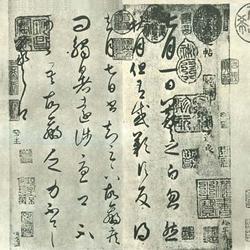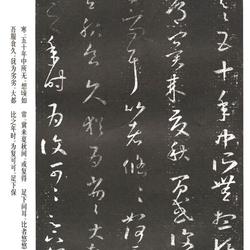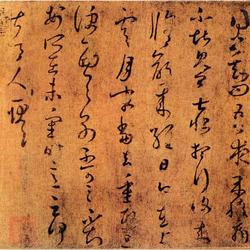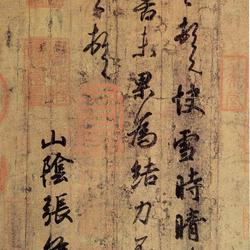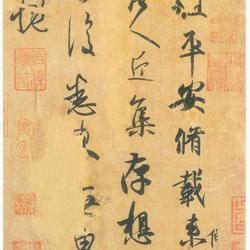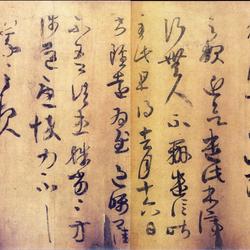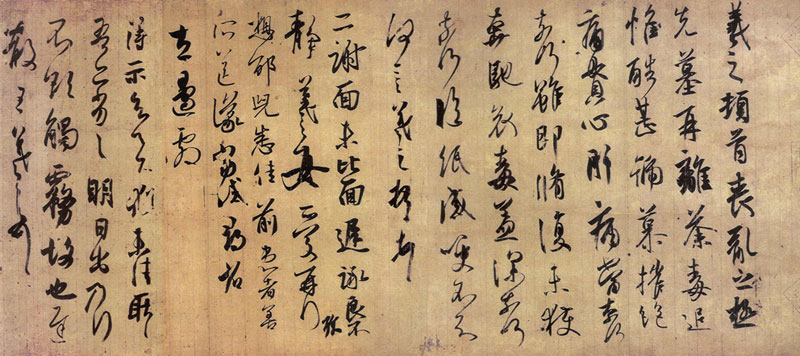
"Sang Luan De Shi Er Xie Tie" is a double-hook and ink-filled copy of the Imperial Household Office in the Tang Dynasty. It was introduced to Japan by envoys sent to the Tang Dynasty during the Nara period. Collection of the Sannomaru Shozo Collection of the Imperial Household Agency of Japan. The right edge of this paper bears the seal of the "Enryaku Edict" written by Emperor Kanmu of Japan (737-806). The original post was a scroll, but now it has been modified into a scroll, which is a combination of three-way rulers and tablets: "Sangluan Post", "Er Xie Post" and "Deshi Post". It was exhibited at the Shanghai Museum in March 2006.
"Sang Luan Tie" has eight lines, "Two Thanks Tie" has five lines, and "Deshi Tie" has four lines, a total of one paper. The Japanese generally call it "Sang Luan Tie". Japanese scholar Naito Mikiyoshi said: The paper used in this post is similar to white linen paper, with vertical stripes, and was copied using the double hook and ink filling method. At the end of the first line, to the right of "Zhi Ji", there is the left half of the word "Seng Quan" signed. At the end of the second line of "Two Thank You Posts", to the right of "Zai Xing", there is a small character "Zhen" signed. ‘Zhen’ refers to Yao Huaizhen, a connoisseur of the Liang Dynasty. At the seam of the paper on the right end of this post, there are three imperial seals of "Yanli Edict" Zhu Wen. The form of the seal is the same as that of "Kong Shi Zhong Tie". The middle seal is in the center, and the upper and lower seals are diagonal to the right, indicating that he was once the emperor of Japan. Hidden by the government. Japan's "China Calligraphy Collection" records: "This painting has been kept in the Imperial Palace for a long time. After the death of Emperor Houxiyuan, it was purchased from Prince Yaoshu." The prince was the pope of the Miao Court, which preserved it to this day and later presented it as an imperial treasure. ’
This calligraphy has been circulated in Japan for more than 1,300 years and is regarded as a national treasure. It has been known to the Chinese calligraphy circle for only more than a hundred years. In the 18th year of the reign of Emperor Guangxu of the Qing Dynasty (1892), Yang Shoujing first imitated his "Lin Su Yuan Tie", and ink prints were introduced after 1934.
Regarding the 'Xian's tomb' and its 'restoration' mentioned in this post, Wang Yuchi, a modern person, presumes that the Xian's tomb was in Luoyang, and its restoration was done in the 78th year of Yonghe, or when Huan Wen regained Luoyang in the 12th year of Yonghe. Han Yutao believed that the first tomb was in Langxie and the restoration was done in August of the twelfth year of Yonghe. Based on the fact that the writing style of this post is quite different from that of "Seventeen Posts", Liu Tao believes that it may have been written by Wang Xizhi around his fiftieth year (the eighth year of Yonghe reign).
The pen of this post is strong, the structure is long and the length is very changeable. It completely gets rid of the remnants of official script and Zhangcao and becomes a very pure cursive style. When writing, he writes first and then scribbles, and when he writes, he scribbles, which shows that his emotions change drastically from depression to excitement.
Han Yutao's article "Evaluation of Wang Xizhi's "Sangluan Post"" said that this post is incompetent for four reasons: first, it is an excellent essay in itself; second, the writing of this post is powerful, and it is the true face of the Right Army and the real The character of Youjun; third, "Sang Luan Tie" has both majestic and bleak beauty; fourth, this post shows the complete process from walking to grass. Therefore, "Sangluan Tie" is a rare treasure and is Wang Xizhi's most representative work in his late years, far better than "Shenlong Orchid Pavilion".
Wang Xizhi's "Song Luan Tie" is in cursive, facsimile, and white linen paper. Length 28.7 cm. 8 lines, 62 words.
"Sangluan Tie" is similar in appearance to "Frequent Sadness Tie", but the transitions are more flexible and flowing, the sides of the characters are even more slanted, the ink is alternately dry and dry, and the writing is faster towards the end of the paper. It can be imagined that the author could not stop sobbing and was extremely sad at that time.
Explanation: Xi Zhi paused and said: The mourning was extremely chaotic, the tomb was buried first and the poison was poisoned, the pursuit was extremely cruel, the admiration was destroyed, the pain penetrated the heart and liver, and it was painful.
No matter what, no matter what! Although it was repaired, it still failed to run smoothly, and the sorrow became deeper and deeper, no matter what! I felt choked when I was laying on the paper, and I didn’t know what to say! Xizhi
The first pause.
Copy of Wang Xizhi's "Deshi Tie", paper version. Length 28.7 cm. 4 lines, 32 words. Cursive writing. Collection of the Sannomaru Shozo Collection of the Imperial Household Agency of Japan. This post is related to
There is one paper in total, "Song Luan Tie" and "Second Thank You Tie".
Interpretation: It has been shown that it is still not good to be content with contentment and to be stubborn. I am also bad. I'll go out tomorrow because I don't want to touch the fog. Late.
Wang Xizhi paused.
Wang Xizhi's "Second Thank You Note" facsimile. Collection of the Sannomaru Collection of the Imperial Household Agency of Japan.
"Two Thank You Posts", "De Shi Posts" and "Sang Luan Posts" are connected into one paper. Length 28.7 cm. 5 lines, cursive writing.
Interpretation: Er Xie has not met yet? Cheng Liang is not quiet after meeting. Xi's daughter loves to worship her again and misses Tai'er well. Former patients are kind. The proposals submitted should be tried to find out the provinces. Drama on the left.

